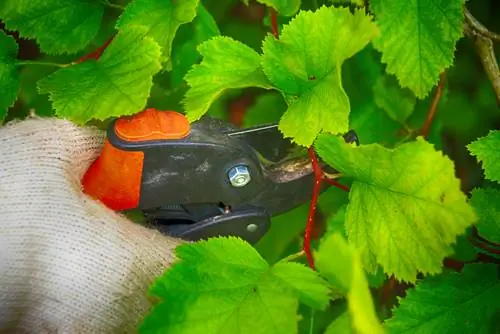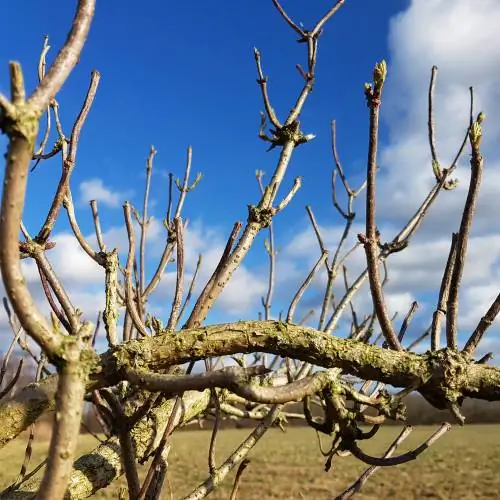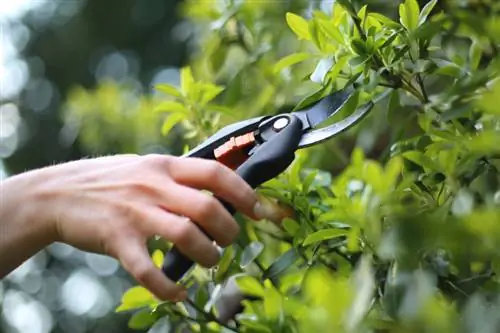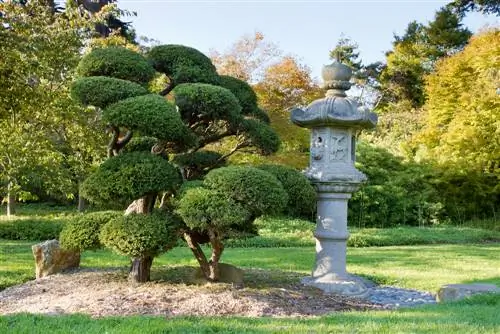- Author admin [email protected].
- Public 2023-12-16 16:46.
- Last modified 2025-06-01 06:02.
Rotthorn adorns the garden as a lavishly flowering house tree. Naturally endowed with tree-like growth, shape and maintenance pruning is only occasionally part of the care plan. Find out here when and how to cut hawthorn correctly.
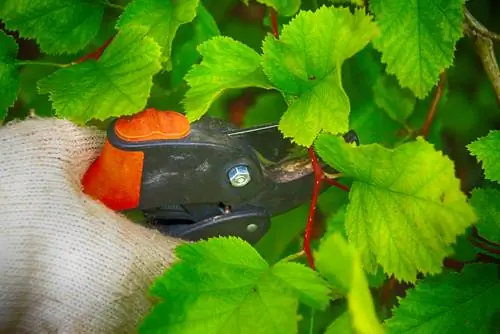
When and how do you cut a hawthorn correctly?
To prune a hawthorn properly, you should make a topiary cut in the summer after flowering, thin out the inside of the crown every 3-4 years and rejuvenate older trees in late winter. Excessively growing shoots are shortened and damaged or withered branches are removed.
Crown after flowering
Like all spring-flowering trees, hawthorn also lays its buds in late summer for the next year's flowering period. If you have prescribed a topiary cut for the tree crown, you should do the work between the end of June and mid-July. If you cut later, there is a risk that valuable flower plants will fall victim to the scissors. How to cut a hawthorn crown into perfect shape:
- Check the hawthorn crown for nesting birds and cut later if necessary
- Cut back shoots that protrude from the crown shape or are heavily drooping
- Place pruning shears just above an outward-facing pair of leaves or side shoots
- Cut off wilted flowers to avoid self-sowing
You cut the treetop in accordance with the Federal Nature Conservation Act if you limit the amount of cutting to this year's growth.
Lighting out at 3-year intervals
A crown flooded with light is the secret to the success of lavish floral displays. For this reason, please devote yourself to extensive thinning every three to four years. To do this, cut out dead wood, damaged branches that grow into the inside of the crown and crosswise. An old farmer's wisdom says: after an exemplary thinning cut, a hat thrown into the crown should fall to the ground.
Rejuvenate old hawthorn - this is how it works
If a hawthorn crown is not granted the occasional thinning cut, baldness and senescence are inevitable. The abundance of flowers visibly decreases from year to year and shifts to just a few shoot tips. That is not a reason for deforestation. How to successfully rejuvenate a hawthorn:
- The best time is during the leafless period, ideally in late winter
- Start by sawing off dead branches on Astring
- Cut back remaining scaffold shoots by up to two thirds
Like all hawthorn species, hawthorn is also busy when it comes to creating sleeping eyes as a growth reserve. The crown sprouts vitally from these dormant buds, even after radical pruning.
Cut thick branch in stages
Often, rejuvenation pruning requires you to completely remove an old, thick branch. If you saw off the branch in question in one go, there is a risk of breakage and damage to the trunk bark. This risk can be avoided by cutting in stages. At a distance of 30 centimeters from the branch ring, saw the branch from the top to the middle. Now move the saw 10 centimeters and saw from below until the branch falls. Saw off the stump just before the branch.
Tip
The high appreciation as a house tree does not mean that hawthorn resists cultivation as a shrub. Thanks to its good-natured tolerance to pruning, the ornamental tree cooperates if you prefer to grow it as a hedge. In this variant, the pruning care consists of a topiary pruning in summer and a thinning pruning in late winter.

